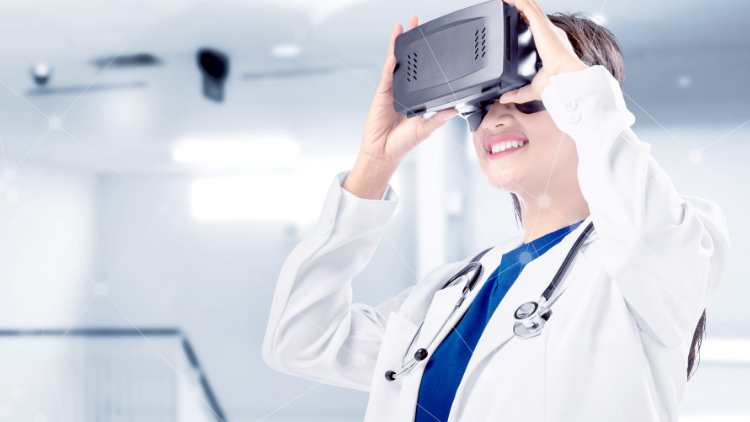Augmented Reality, or more popularly known as AR, is the most promising thing to look forward to implementing AR in the healthcare sector. Think about how Pokemon Go proved revolutionary, in the augmented reality gaming space. Just imagine, AR augmenting real-life scenarios such as performing complicated surgeries, doing internal diagnostics, helping medical practice, studying human anatomy, spreading healthcare education, etc.
Pokemon Go took the whole gaming industry to next level with augmented reality. Even Dr Rafael Grossman, the world’s first surgeon to operate a surgery with a Google Glass, agrees to this. As a result, AR garnered the attention of a lot of people to have an interaction with real-life things through digital imagery.
To have a brief understanding of what impact augmented reality can have on medical and healthcare, let us take an example. Having an indirect view of organs via computer-generated GPS data, graphics, video, and sound allow one to look inside without dissecting them. AR devices like the lens, headsets, glasses, etc. help in doing this.
However, both are quite different even if they sound the same. VR detaches users completely from the real world with no real-time information, while AR allows users not to detach from reality while delivering real-time information.
Opportunities offered by AR in Healthcare
As we saw, AR can offer a lot of potential in medicine and healthcare. AR innovations help doctors to diagnose, treat, and operate patients. Also with more accurately using real-time data associated with patient health records. It further allows people to take up education in a more realistic manner with real-life medicine or operating procedure scenarios.
AR has an unimaginable scope in the healthcare sector across devices, equipment, medicine, and so much more. It is simply impossible to cover them all. However, let us look at the five most important use cases wherein AR can do wonders.
1. Augmented Healthcare Education
By using AR in healthcare education, students can be educated regarding how to handle the treatment procedure and medicines related to a patient. This can be done through a mix of the actual human body with augmented imagery of internal organs. With a display system in place, a digital combination of virtual and real images helps with surgical planning, training, and medical education.
Information rendering as a result of real scenarios and virtual interactivity, help in manipulating the human body with a real impression. Augmented reality does bring together a virtual environment into a physical one allowing students to have a realistic feel.
Valuable information related to the body is offered by simulating the human body. The hands-on treatment experience is imparted by having an augmented visualization of the body. Rather than operating on real bodies, AR gives the advantage to handle real-life complex procedures.
2. Augmented Human Anatomy
Human anatomy can be studied in a more precise manner incorporating AR in healthcare. Augmented reality helps to visualize every part of the body from within, such as organs, muscles, bones, etc. Furthermore, the 3D model helps in passing on vital information related to drugs to companies for identifying what drugs can work best for the human body using an AR-enabled technology kit.
3. Augmented Surgery
Real-time information of patients lying on the operation table, guide surgeons with key information to make decisions through simple or complex operating procedures. The anatomy of patients can be seen in advance of an operation with the help of CT and MRI scans using an AR headset. Furthermore, a lot of inner parts such as nerves, arteries, veins, blood vessels, etc. can be seen for a comprehensive analysis.
Such use of AR in healthcare further help surgeons to give injections and do incisions on the body wherever required. Life-saving information could be made readily available to the paramedics in medical emergencies. Furthermore, low or high-risk surgeries can be accomplished with all the information available on the AR screens.
Also Read : 7 Angular Features That Can Make Any Digital Product Successful
4. Augmented Diagnosis
Another aspect of AR in healthcare is the diagnosis arena, which enables doctors to determine the symptoms of the patients. Most of the time, patients are unable to tell about the actual symptoms. In such cases, doctors or nurses look through the condition using augmented tools or apps connected with the medical equipment.
5. Augmented Practice
The benefits of AR in healthcare are simply limitless, and medicine is no different. Augmented reality has been playing a critical role as well in practice. AR hardware can play an important role in identifying the right kind of medicine. Just wearing it on the practitioner’s head gives a visual image of the diseases and accordingly, medicines are recommended.
AR in Healthcare has a long way to go
High-level technological advances in healthcare have pushed augmented reality remote assistance to a whole new level. With the pandemic thing still going on, this is the time when AR should potentially see a rise with all the future developments to come. AR has already seen an upside potential since its inception, and its application is only rising with digital transformation in medical and healthcare.
Some social challenges associated with augmented reality in healthcare. Of course, AR equipment and devices are costlier to spend, and it can be a major hurdle. But, more importantly, people with conventional mindsets might not accept this.
But then every technology has people in favor of going against it. Today, it is all about diagnosing patients promptly, deciding upon treatment to start right away, & operating sooner than ever to save health and lives. All this is possible with augmented reality.
Irrespective of both kinds of thinking prevailing in the health tech scenario. AR is here to stay for a long time due to unimaginable timely benefits to individual health. This is where we are heading towards!

